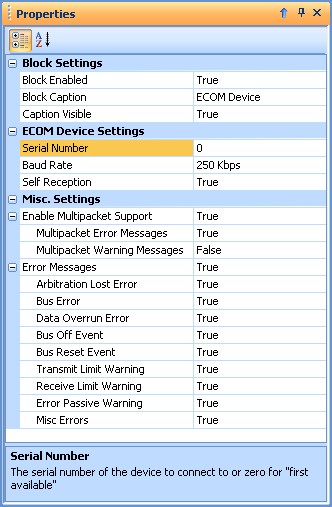ECOM Block
 The ECOM function block is used to represent an ECOM device physically connected to the local computer. As each message (or error frame) is received from the CAN bus, it is sent to the output port of the block. If a trace is connected to the input port of the ECOM block, then each incoming message that is received will be transmitted on the respective CAN bus.
The ECOM function block is used to represent an ECOM device physically connected to the local computer. As each message (or error frame) is received from the CAN bus, it is sent to the output port of the block. If a trace is connected to the input port of the ECOM block, then each incoming message that is received will be transmitted on the respective CAN bus.
 The ECOM block is typically the source of all messages throughout the CANCapture flow chart. Using the flexible nature of CANCapture's flow chart, one can easily wire and route the messages received on the CAN bus in an unlimited number of ways. For example, the output port of one ECOM block can be routed to the input port of another to create a simple bridge between two CAN buses. Alternately, a packet filter or custom script can be placed between the two so that only specific messages will be forwarded - the possibilities are virtually endless.
The ECOM block is typically the source of all messages throughout the CANCapture flow chart. Using the flexible nature of CANCapture's flow chart, one can easily wire and route the messages received on the CAN bus in an unlimited number of ways. For example, the output port of one ECOM block can be routed to the input port of another to create a simple bridge between two CAN buses. Alternately, a packet filter or custom script can be placed between the two so that only specific messages will be forwarded - the possibilities are virtually endless.
Every message that is received by the ECOM block contains a hardware timestamp that is accurate within microseconds. The ECOM is capable of capturing CAN 2.0A (11-bit), CAN 2.0B (29-bit) messages, and all CAN error frames. All messages are fully supported throughout the CANCapture database and software.
J1939 multipacket and NMEA-2000 Fast Packet messages are seamlessly supported by the ECOM block. Immediately after the final packet of the J1939 connection management session is received, the reassembled multipacket message will be injected into the stream (unless disabled in the ECOM block properties). All other blocks that receive this message will treat it like a normal packet. This means that a packet-watch can monitor the packet's statistics; additionally user panels, graphs, and variable-watches can all access each variable of the multi-packet message.
If more than one ECOM device needs to be used in a CANCapture flow chart, the properties of each block can be manually configured to assign a specific device serial number to each. In addition specific CAN error frames and J1939 multi-packet support can be enabled or disabled in the properties.

